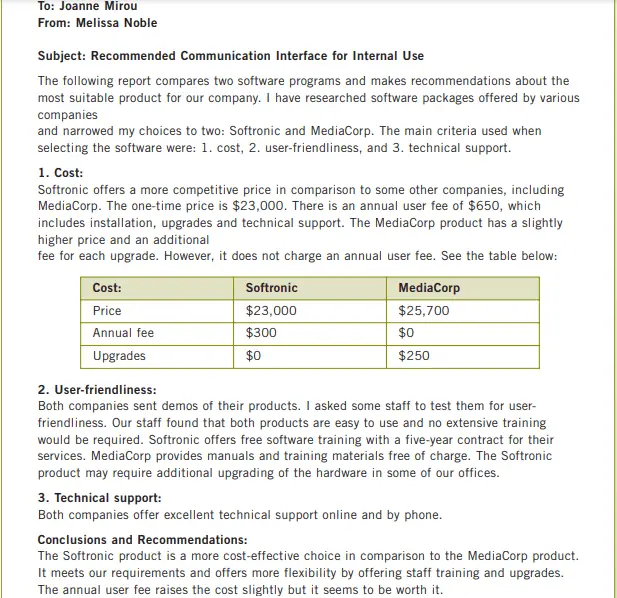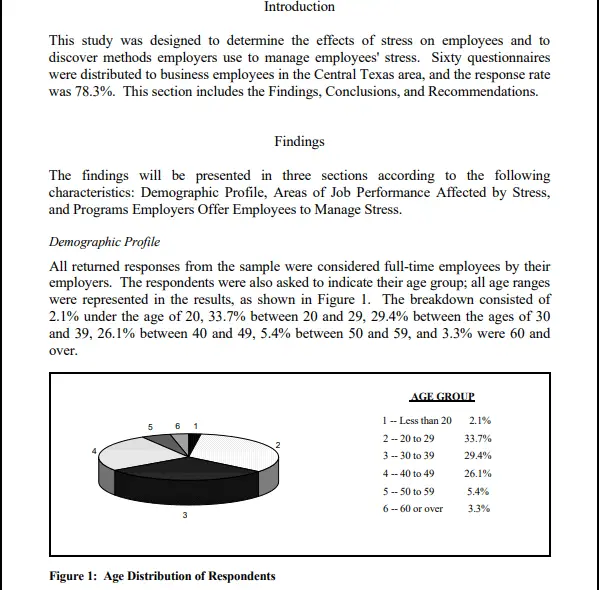Overview of Formal and Informal Reports
Formal Report:
A formal report is a structured and comprehensive document that presents detailed information and findings on a specific topic or issue. It is typically written for a specific audience, such as supervisors or decision-makers, to provide them with accurate information to make informed decisions or take necessary actions.
A formal report follows a predefined format, which includes sections such as an executive summary, introduction, methodology, findings, analysis, conclusions, and recommendations. The language used in a formal report is precise, objective, and free from personal opinion.
Informal Report:
An informal report is a type of document that presents information, analysis, or recommendations in a less structured and more conversational manner. Unlike formal reports, which follow a specific format, informal reports are often used for internal communication within an organization or between colleagues.
They are typically shorter in length and may not include all the sections found in a formal report, such as a title page or table of contents. The purpose of an informal report can vary widely, ranging from sharing updates on project progress to providing recommendations for a particular issue.
Further Reading: What is informal report writing
Table of comparison for formal vs informal reports
Differentiation Aspect | Formal Reports | Informal Reports |
Purpose and Audience | Prepared for significant situations & target higher-level management. | Used for day-to-day operations and internal updates. Shared among team members or colleagues. |
Structure and Components | Follow specific guidelines and structured format. | Flexible format and less rigid structure. |
Language and Tone | Formal language and professional tone. | Casual language and conversational tone. |
Formatting and Presentation | Stick to formatting rules. Use of headings, subheadings, and numbering | Flexible formatting, may not strictly follow formatting rules. |
Length and Detail | Detailed and comprehensive, Extensive information and analysis. | Concise and focused on key points. |
Use of Technical Jargon | May include technical terminology. Relevant to the subject matter. | Less emphasis on technical jargon. Focus on clear and understandable language. |
Use of Citations | Extensive use of citations. Extensive use of citations. | Basic citations, if external sources are used. |
Use of Visual Aids | Incorporate a wide range of visual aids (charts, graphs, tables) | Utilize simpler visual aids (e.g., basic charts or bullet-pointed lists) |
Review and Approval Process | Formal approval process involving, higher-level management. | Less formalized approval process. Direct sharing among team members. |
Decision-making Implications | Guide strategic decision-making & provide well-supported recommendations | Influence tactical decision-making & Impact day-to-day operational decisions. |
Importance of understanding the difference between formal and informal reports
Understanding the distinction between formal and informal reports is essential for successful business communication.
When a writer understands the differences between these two types of report writing, they can customize various elements, such as content, tone, structure, and format, to suit the specific purpose, audience, and organizational context.
By doing so, the writer can optimize the impact of the report and enhance its effectiveness in achieving its objectives.
10 basic differences between formal and informal reports (detailed explanation)
1/ Purpose and Audience:
Formal Reports: In formal reports, the purpose is often to provide detailed information, analysis, and recommendations on a specific topic or problem. These reports are typically prepared for a specific audience, such as senior management, board members, or stakeholders. The primary goal of formal reports is to support decision-making and offer well-supported recommendations that can have significant consequences for the organization.
Informal Reports: On the other hand, informal reports have a more limited scope and are generally used for internal communication within an organization. They are usually intended for a smaller and more immediate audience, such as immediate supervisors, colleagues, or team members. Informal reports are often used to convey routine updates, progress reports, or quick summaries of work-related activities.
2/ Structure and components:
Formal Reports: Formal reports follow a structured and standardized format to ensure clarity, organization, and professionalism. They typically consist of several essential components that help convey information effectively. These components include Title Page, Table of Contents, Executive Summary, Introduction, Methodology, Findings and Analysis, Recommendations, Conclusion, and Appendices.
Informal Reports: Informal reports have a more flexible structure and often exclude certain components found in formal reports. They are generally shorter and less detailed. The structure of an informal report may include an Introduction, a Discussion of Findings, a Conclusion, or a Summary.
3/ Language and tone:
Formal Reports: Formal reports are characterized by a professional and objective tone, reflecting formal conversation. The language used in formal reports is typically formal and precise with formal expressions. The writing style focuses on conveying information accurately and concisely, using clear and consistent sentences. The tone remains neutral and unbiased, emphasizing the importance of presenting facts, data, and analysis objectively.
Informal Reports: In comparison, informal reports adopt a more conversational tone. The language used is less formal and more relaxed, allowing for an approachable communication style. Informal reports often incorporate everyday language and may include idiomatic expressions or informal vocabulary suitable for the specific audience and working environment.
4/ Formatting and presentation:
Formal Reports: Formal reports follows specific formatting guidelines to ensure professionalism and consistency. They use standard fonts, uniform margins, and clear headings and subheadings. Visual aids are incorporated, citations and references are included, and language and grammar follow formal standards.
Informal Reports: Informal reports have more flexible formatting, adapting to individual or organizational preferences. Fonts, margins, and spacing can vary. Visual aids are simpler, and language and grammar may be more relaxed while maintaining clarity.
5/ Length and detail:
Formal Reports: Formal reports tend to be longer and more detailed compared to informal reports. They aim to provide a comprehensive and in-depth analysis of a specific topic or issue. Formal reports often include extensive research, supporting data, and detailed explanations of the methodologies used.
Informal Reports: In contrast, informal reports are generally shorter and more concise just like a short business report. They focus on providing essential information without going into extensive detail. Informal reports aim to deliver updates, summaries, or brief analyses on specific tasks, progress, or issues. The level of detail in informal reports is typically tailored to the specific needs of the audience.
6/ Use of technical jargon:
Formal Reports: Formal reports often utilize technical jargon and specialized terminology relevant to the subject matter. Since formal reports are intended for a professional audience with a certain level of expertise in the field, the use of technical terms can help ensure accuracy in conveying information.
Informal Reports: In contrast, informal reports generally avoid excessive use of technical jargon. These reports are often intended for a wider range of audiences within the organization, including colleagues, immediate supervisors, or team members from various departments or backgrounds.
7/ Use of citations and references:
Formal Reports: Formal reports place significant emphasis on citing and referencing external sources to support claims, findings, and recommendations. These reports often involve extensive research, and it is essential to provide proper attribution to the works of others.
Informal Reports: In general, informal reports may not require extensive citations and references. They are more focused on conveying brief updates, summaries, or internal communications within the organization. However, if any external sources or references are used to support specific points or ideas, it is good practice to provide a mention of the source appropriately.
8/ Use of visual aids:
Formal Reports: Formal reports often incorporate various types of visual aids to enhance understanding and present data in a visually appealing manner. These include graphical representations, such as infographics, graphs, tables, maps, diagrams, charts, and more. These visual representations help to illustrate complex information, trends, patterns, or comparisons more effectively than lengthy textual explanations alone
Informal Reports: While not as extensively used as in formal reports, informal reports may also utilize visual aids to convey information concisely and enhance readability. These visual aids tend to be simpler and more straightforward, such as basic charts or bullet-pointed lists.
Related Reading: Advantages and Disadvantages of visual aids
9/ Approval and distribution:
Formal Reports: Formal reports typically undergo a formal approval process before being distributed to the intended recipients. These reports are often reviewed by supervisors, managers, or stakeholders who have the authority to validate the accuracy, quality, and appropriateness of the report’s content.
Informal Reports: In contrast, informal reports may have a less formalized approval and distribution process. Depending on the organizational culture and reporting structure, informal reports may be shared directly among team members, colleagues, or immediate supervisors without the need for formal approval.
10/ Decision-making implications:
Formal Reports: Formal reports have significant implications for decision-making processes within an organization. These reports are often prepared to provide comprehensive analysis, evaluate options, and make recommendations to guide strategic decisions.
Informal Reports: Informal reports also have decision-making implications, although to a lesser extent compared to formal reports. While informal reports may not carry the same level of detailed analysis or comprehensive recommendations, they still contribute to decision-making processes within teams, departments, or immediate supervisors.
Examples of informal and formal reports:
Examples of informal report

Examples of a formal report

Benefits and Limitations of Formal and Informal Reports
Formal and informal reports serve different purposes and are used in various contexts. Here are the benefits and limitations of both types of reports:
Benefits of formal reports
- Standardization: Formal reports often follow specific templates or guidelines, ensuring consistency in formatting, language, and presentation. This standardization makes it easier for readers to navigate and understand the content.
- Comprehensive Information: Formal reports are typically more detailed and comprehensive. They involve integrating relevant data and supporting evidence, which in turn enables decision-makers with the information required to make well-informed choices.
- Documentation: Formal reports serve as an official record of information, decisions, and actions taken within an organization. They provide a reliable source of information that can be referred to in the future for auditing, legal, or historical purposes.
Limitations of formal reports
- Time-consuming: Preparing a formal report requires careful planning, research, data analysis, and writing. This process, particularly when addressing complex topics or dealing with a substantial amount of data, can be time-consuming.
- Complexity for Non-experts: Formal reports, especially those involving technical or specialized information, may be challenging for non-experts to comprehend.
Benefits of informal reports
- Ease of Preparation: Informal reports are often quicker and easier to prepare compared to formal reports. They may not require extensive research or complex analysis, making them suitable for situations where a quick update or summary is needed.
- Accessibility: Informal reports typically use plain language and avoid technical jargon, making them more accessible to a broader audience.
- Incorporate Informal Communication: Informal reports facilitate a more casual and informal style of communication. They can encourage dialogue, collaboration, and the exchange of ideas between colleagues or team members.
limitations of informal reports
- Informal Tone: Informal reports often adopt a more conversational tone, which may not always be suitable for certain professional or formal settings.
- Credibility Concerns: Due to their casual nature, informal reports may be perceived as less credible or authoritative compared to formal reports. This can be a limitation when the information presented in the report needs to carry a significant weight or impact decision-making processes.
What is the difference between a memo and an informal report
The below table compares memos and informal reports based on eight key differences:
Criteria | Memos | Informal Reports |
Purpose | To communicate information or make requests within an organization | To provide detailed information or analysis on a specific topic |
Length | Typically shorter, ranging from one to a few pages | Longer, often several pages or more |
Structure | Brief and concise, with a simple format and sections | More structured, with an introduction, body, and conclusion |
Tone | More formal and professional, using a business-like tone | Can be less formal, allowing for a more conversational tone |
Recipients | Usually internal, within the same department or organization | Can be internal or external, depending on the intended audience |
Subject Matter | Covers routine matters, updates, announcements, or requests | Addresses specific topics, issues, or research findings |
What is the difference between formal letters and formal report
Below mentioned table outlining eight key differences between formal letters and formal reports:
Aspect | Formal Letters | Formal Reports |
Purpose | Communicate a specific message or request | Present detailed information, analysis, or findings |
Structure | Opening (salutation), body, closing (complimentary close) | Title page, abstract, introduction, main body (sections/subsections), conclusion, recommendations, references, appendices |
Recipient | Usually addressed to a specific individual or organization | Can be directed to a broader audience, such as stakeholders or decision-makers |
Tone | Polite and courteous | Objective and professional |
Length | Generally shorter (1-2 pages) | Typically longer (multiple pages) |
Formatting | May include a letterhead and date | Includes a formal report format with headings, subheadings, and sections |
Language | More conversational and personalized | Formal and concise, using technical terms if necessary |
Signature | Usually signed by the sender | Signed by the author(s) and may include additional approvals or comments |
Related Reading: Distinctions between Formal and informal letters
What is formal and informal language in report writing
Formal and informal language are two distinct styles of writing, and understanding their differences is crucial in report writing. Formal language is characterized by a professional and objective tone, following established conventions and standards.
It employs precise vocabulary, and proper grammar, and avoids personal opinions or subjective language. In formal reports, such as academic or business formal reports, the language is structured, and logical, and emphasizes a professional demeanor. It often uses third-person pronouns and maintains a serious and authoritative tone.
In comparison, informal language adopts a more relaxed and conversational tone. It is often used in personal or casual contexts. Informal language may employ colloquialisms and contractions. While it can be engaging and approachable, it is generally considered less appropriate for formal reports.
Overall the choice between formal and informal language in report writing depends on various factors such as the purpose of the report, the intended audience, and the level of formality required.
Choosing between formal and informal report
Choosing between a formal and informal report depends on various factors, including the purpose of the report, the audience, and the organizational culture.
The following are some instances where a formal report might be appropriate:
- Business Proposals: When presenting a proposal to potential clients, investors, or stakeholders, a formal report is often preferred.
- Annual Reports: Organizations often prepare formal reports to summarize their activities, financial performance, and achievements throughout the year.
- Compliance or Audit Reports: When conducting internal audits, compliance assessments, or legal investigations, formal reports are essential.
Here are some scenarios where an informal report might be appropriate:
- Progress Updates: Informal reports are ideal for providing regular progress updates within a team or department.
- Meeting Summaries: After a meeting, an informal report can be used to summarize the discussions, decisions, and action items.
- Memos: In day-to-day communication, an informal report in the form of a memo can be used to convey information, instructions, or updates to colleagues or subordinates.
Frequently asked question
Q1) What are the differences between an informal report and a formal report list at least five points?
Ans: Informal reports differ from formal reports in their structure, length, audience, language, and documentation. Considering these differences helps determine the appropriate type of report for a given situation or audience.
Q2) What are the two main categories of reports to explain the difference?
Ans: Reports can be broadly categorized into two main types: informational reports and analytical reports. Informational reports provide objective facts and details about a specific topic, without offering analysis or interpretation. Analytical reports, on the other hand, analyze information, data, or problems to derive insights, make recommendations, or support decision-making.
Q3) What is another name for an informal report?
Ans: Another name for an informal report is a “casual report” or a “memo.” These terms are often used interchangeably to refer to a less formal, more conversational type of report.
Q4) What are the 3 differences between formal and informal writing?
Ans: Formal and informal writing differ in tone, structure, and audience. Formal writing has a serious, professional tone, follows a structured format, and targets a professional or academic audience. Informal writing has a conversational tone, and a more flexible structure, and is tailored to a familiar or casual audience.
Q5) What are the two types of reporting tools?
Ans: There are two types of reporting generation tools commonly used in various organizations: Data visualization tools and analytical reporting tools. Data visualization tools are specialized software or applications that transform raw data into visual representations such as charts, graphs, maps, and interactive dashboards. In contrast, analytical reporting tools have the purpose of analysis and interpretation of data, aiming to extract valuable insights, recognize patterns, and provide support for strategic decision-making.



